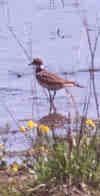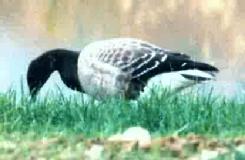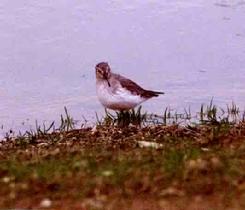 |
| Bluebird |
|
|
 |
| Shared nesting box |
|
Because of the diverse environment, a combination of low flat wetlands near a wooded stream bed with a background of scrub verge and low ridge woodlands, we get a nice diversity of birds.
We give added incentive to the bluebirds by providing bluebird boxes, 75 in the area; however, since the other birds don't know that they're bluebird boxes specifically, we also have swallows and sparrows in these nesting boxes.
|
 |
| Woodpeckers are welcome inhabitants of the wetlands. Besides being delightful to observe, they are beneficial to our trees by eating LOTS of insects and larvae. |
|
|
 |
| The numerous swallows that inhabit the wetlands during the summer and well into fall have favorite perches, one of which is the electric fence around the horse pasture. Because they're not grounded , they suffer no jolt! The swallows earn their keep here by eating their weight in insects, including mosquitos. Thanks, guys. |
|
|
 |
| Another insect feeder, a white-breasted nuthatch, hunts for its dinner in the tree bark. |
|
|
 |
| Eastern phoebe nest |
|
|
We also provide several wood duck boxes, but found this winter that a little screech owl had taken over one of these as a shelter against harsh weather. It's not unusual in nature for birds to share nesting spaces. Our barn is simultaneously host to barn swallows, cliff swallows and chimney swifts, as well as robins, sparrows, and anyone else who can squeeze in!
|
Since the small birds which are an important part of the food chain maintain a presence here, we also have hawks, harriers and kestrals perpetually in the area.
|
 |
| Sharpshin hawk |
|
|
 |
| Turkey hens |
|
| As well as grassland birds such as pheasants and turkeys.
|
 |
| Pheasant |
|
|
And of course you find a wide array of ducks, geese, herons, storks, and other water birds in attendance.
This is a wetlands after all.
|
|
 |
| Kildeer |
|
|
 |
| A Brant Goose browses the dike at the new, aptly named, Brant Marsh. This small goose is rarely seen in our area and so you can understand our excitement when he decided to rest here for about 10 days. He seemed little concerned about the attention and having his picture taken numerous times. |
|
|
 |
| The dunlin and the semipalmated plover are among the large numbers of shorebirds that visit the wetlands. Their fast moving antics are a joy to watch. We love the little sora rails that raise a cacophony beyond their small size when courting. Evenings are far from quiet when you have a combination of soras and spring peepers! Yellow legs,semipalmated sandpipers and greenback herons can be seen almost on a daily basis, while you have a good chance of seeing dowitchers, snipes, bitterns and woodcocks are varying times of the year. |
|
|
 |
| The red-breasted merganser is easily identified. This male in full breeding plumage has the obvious coloration and shape (he's a low-rider), and his "Don King" haircut is a hundred percent giveaway. Mergansers are divers and are frequently seen at the wetlands. |
|
|
 |
| This belted kingfisher spends alot of time checking out the ponds for a fish dinner. The snag he is perched on is typical. They're not really shy. This is a male, the female, unlike most species of birds, is prettier, with a rufous band across her breast. The kingfisher does some amazing dives when looking for a meal. |
|
|
 |
| The blue teal ducks used to be migratory visitors but have now become breeding seasonal inhabitants of Whitetail Wetlands. |
|
|
 |
| Egrets in blue. |
|
|
 |
| The great egret is a frequent summer visitor to the wetlands. |
|
|
 |
| Green herons enjoying a warm summer morning. It's late summer and the juveniles are almost as big as their parents. The entire family numbered five but the youngsters love to fly around and pick fights with each other. Typical teenagers. |
|
|
|




